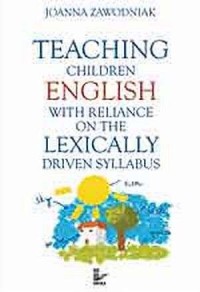Teaching Children English with Reliance on the Lexically Driven Syllabus
Joanna Zawodniak

| Dane szczegółowe: | |
| Wydawca: | Oficyna Wydawnicza Impuls |
| Oprawa: | miękka |
| Ilość stron: | 162 s. |
| Wymiar: | 167x240 mm |
| EAN: | 9788373085879 |
| ISBN: | 83-7308-587-4 |
| Data: | 2007-07-25 |
Opis podręcznika:
The book is devoted to the elaboration and evaluative examination of the present author’s lexically driven syllabus design addressed to the oparational children aged 8 and 9. its aim was to ensure the young learners a stress-free, semantically organised flow from the right, non-verbal, imaginative hemisphere to its left, verbal, logical counterpart. The syllabus design became subject to the empirical research drawing on formal experiment and differential case study. Formal experiment findings pointed to the experimental groups vocabulary knowledge as significaly exceeding the knowledge displayed by the control groups. Case study findings pointed on syllabus design as being better suited to “8-year-old’s” learning needs. As a result, the lexically driven syllabus design turned out to be a faciliative, theoretically consistent and methodologically diversified tool in child L2 education, bridging the gap between non-verbal and verbal spheres of activity.
"[...] Autorka dokonuje wyboru tych technik, które właściwe są dla nauczania dzieci – techniki reakcji całym ciałem, techniki tablicy flanelowej oraz technik relaksacyjnych i wizualizacji kontrolowanej. [...] Publikacja ta pozwoli nauczycielom [...] krytycznie spojrzeć na możliwość realizacji celów dotyczących struktury języka. Nauczyciele ponadto dostają propozycję programu nauczania i koncepcję jego zastosowania sprawdzoną w polskiej szkole. Natomiast studenci dodatkowo dostają nieomalże wzorcowy model prowadzenia badań empirycznych w dziedzinie glottodydaktyki”.
(Z recenzji prof. zw. dr. hab. Teresy Siek-Piskozub)
Podręcznik „Teaching Children English with Reliance on the Lexically Driven Syllabus” - oprawa miękka - Wydawca: Oficyna Wydawnicza Impuls.
Spis treści:
Introduction
Part One. Theoretical Underpinnings of the Lexically Driven
Syllabus Design
1. Child development
1.1. Biological foundations of brain growth
1.1.1. Brain anatomy from the phylogenetic point of view
1.1.2. The human brain from the ontogenetic point of view
1.2. Towards the elucidation of global development concept
1.2.1. Learning process as viewed by associationists and gestaltists
1.2.2. Constructivist espousal of global learning
1.3. Cognitive aspect of the human mind
1.3.1. Claparède’s approach to aptitude and awareness
1.3.2. Piaget’s model of cognitive development
1.3.3. Ausubel’s Meaningful Learning and Retention Theory
1.3.4. Memory as a cognitively organised repository of human knowledge
1.4. Affective aspect of the human mind
1.4.1. Interpersonal factors in Vygotsky’s theory
1.4.2. Bruner’s intersubjective approach to education
1.4.3. Erikson’s psychosocial theory of human development
1.4.4. The role of emotional intelligence in the learning process
1.5. Psychomotor aspect of the human mind
1.6. Creativity and its impact on global learner development
2. Vocabulary as the crucial component of child L2 acquisition
2.1. L2 acquisition in relation to global learner development
2.1.1. Critical period hypothesis
2.1.2. Acquisition-learning spectrum
2.1.3. Zone of child proximal L2 competence
2.1.4. The role of interlanguage
2.1.5. Interactionist stance on language learning
2.1.5.2. Bialystok’s model
2.1.5.2. Sampson’s model
2.1.6. Child as a fi eld dependent, competitive learner
2.2. Vocabulary and meaning
2.2.1. The etymology and defi nition
2.2.2. The taxonomy
2.2.3. Corpus-based study of vocabulary
2.2.4. The nature of meaning
2.2.4.1. Vygotsky’s conception of individualised and generalised meanings
2.2.4.2. Bruner’s interpretive approach to meaning
2.2.4.3. Exploratory dimension of meaning in vocabulary acquisition
2.3. Formulas and their place in vocabulary development
3. Vocabulary in foreign language teaching
3.1. Vocabulary and its place in the history of L2 pedagogy
3.2. Recent tendencies in vocabulary instruction
3.2.1. The Natural Approach
3.2.2. The Collins COBUILD English Course
3.2.3. The Communicative Approach
3.2.4. The Lexical Approach
3.2.5. The European Co-operation Programs
3.3. Multi-sensory approach to vocabulary instruction
3.3.1. Neuro-Linguistic Programming (NLP)
3.3.2. Total Physical Response (TPR)
3.3.3. The fl annelgraph technique
4. The lexically driven syllabus design
4.1. Rationale for the syllabus design
4.2. Learning/teaching goals
4.2.1. Lexically organised content of the syllabus design
4.2.2. Skills
4.3. Brain-compatible vocabulary instruction
4.3.1. Lesson structure
4.3.2. Activity ladder
4.3.3. Textbook support of the syllabus design
4.3.4. Lesson scenario exemplar
Part Two. Research
5. Formal experiment
5.1. Organisational principles
5.1.1. Experiment area
5.1.2. Aim
5.1.3. Focus questions and hypotheses
5.1.4. Experiment constructs
5.1.5. Subjects
5.1.6. Types of data
5.1.7. Variables
5.2. Knowledge claims
5.2.1. Vocabulary differentiation
5.2.2. Vocabulary comprehension
5.2.3. Vocabulary divergent use
5.3. Evaluative remarks
6. Differential case study
6.1. Organisational principles
6.1.1. Case study area
6.1.2. Aim
6.1.3. Focus question
6.1.4. Case study constructs
6.1.5. Subjects
6.1.6. Types of data
6.2. Knowledge claims
6.2.1. Experimental group 1
6.2.2. Experimental group 2
6.3. Evaluative remarks
6.4. Advantages and limitations of the lexically driven syllabus design
Conclusions
Summary
Bibliography
Appendices
Appendix 1. Vocabulary test
Appendix 2. VAK quiz
Appendix 3. TPR + the fl annelgraph technique
Appendix 4. Guided fantasies
Appendix 5. Relaxation activities
Appendix 6. “Pat & Rhett” – textbook support of the syllabus design

